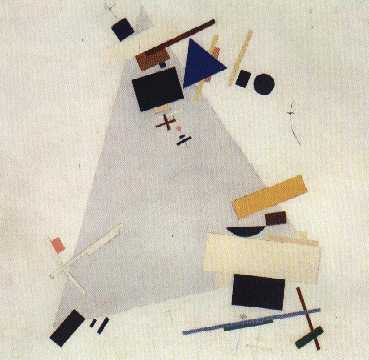Russian Art - Suprematism, Constructivism, Kinetic Sculpture
In Malevich's later development of Dynamic Suprematism (1915), smaller geometric forms
are superimposed upon larger elements. Consequently, a sense of floating movement
becomes more evident than in the previous works, and a much greater spatial tug is
established between the shapes, although the white ground remains consistent with the
earlier paintings.
Influenced by Malevich's command of dynamic non-figurative design, he expanded the
application of these principles to different materials, from chunky constructions in wood
that are as spare as Minimal art - or the paintings of Mondrian - to hanging constructions
that introduced physical movement - purely abstract kinetic sculpture. Movement soon
became a dominant feature in Constructivist art.

above: Kasimir Malevich, Suprematist Composition, c. 1916
Tatlin's non-representational Corner Counter Reliefs (1915) concentrated on physical matter
by employing 'real materials in real space' (such as wood, metal and string) and by exploiting
the inherent properties and colour of each substance.
A rather different notion of construction was developed by the sculptor Naum Gabo
(1890-1977). During the limited years he spent in Russia after the Revolution, Gabo
actively explored the dematerialization of traditional mass and volume; he investigated
dynamic forms in space, and even kinetic possibilities for sculpture, as in Kinetic
Construction No. 1 (1920), where a single metal rod was attached to a small motor,
making it vibrate into a pattern.
Back to top
Back to Towards Abstraction
Back to Home

